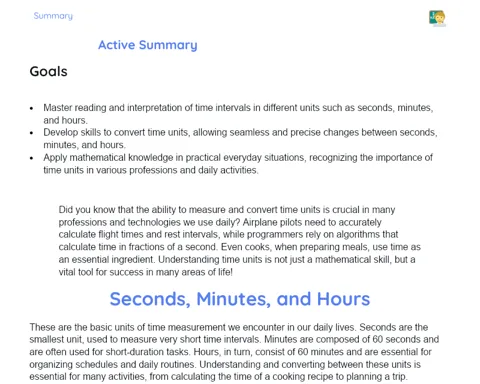Greater or Lesser | Active Summary
Objectives
1. 🎯 Understand and apply the concept of greater and lesser in sets of natural numbers.
2. 🎯 Develop skills to order sequences of numbers in ascending and descending order.
3. 🎯 Utilize the acquired knowledge to solve everyday problems involving the comparison and ordering of quantities.
Contextualization
Did you know that the concept of 'greater' and 'lesser' applies not only to numbers but is a fundamental idea we use all the time in our lives? From choosing the largest piece of cake to organizing our to-do list from the most urgent to the least urgent, the ability to compare and order is an essential skill. In the world of mathematics, understanding how to do this with numbers can help us solve complex problems and even decipher codes! Ready to become a master at ordering and comparing? Let's go!
Important Topics
Number Ordering
Number ordering involves placing a sequence of numbers in a specific order, usually ascending or descending, based on their value. This concept is fundamental to developing the understanding of greater and lesser, which are essential in several mathematical applications and practical day-to-day situations. For example, when organizing a list of product prices, you need to know which is the highest or lowest value.
-
Ascending order: Numbers are arranged from the smallest to the largest value.
-
Descending order: Numbers are arranged from the largest to the smallest value.
-
Justifying the position: It's important to understand and be able to explain why a number is placed before or after another.
Number Comparison
Number comparison is the ability to determine if a number is greater, lesser, or equal to another. This is crucial for making informed decisions in various situations, such as buying items at the best price or classifying objects by size. Number comparison is also a basis for understanding more complex mathematical operations.
-
Greater than (>), less than (<), equal to (=): Symbols used to express the relationship between two numbers.
-
Use of comparison signs: Learning the correct usage of signs in different contexts.
-
Practical applications: Using number comparison in everyday situations, such as games or financial planning.
Everyday Applications
The ability to order and compare numbers is not limited to the school environment but is applied daily in various situations, such as organizing tasks by priority, calculating discounts, or measuring and comparing ingredients in recipes. Mastering these techniques helps improve decision-making and solve problems more effectively.
-
Planning: Using ordering to plan daily activities or larger projects.
-
Shopping and discounts: Comparing prices and calculating discounts to save money.
-
Measurements: Comparing and ordering measurements in recipes, construction projects, or sports activities.
Key Terms
-
Ordering: The action of placing numbers in a specific sequence, usually ascending or descending.
-
Comparison: The process of determining the relationship between two numbers, whether one is greater, lesser, or equal to the other.
-
Comparison Signs: Mathematical symbols (> greater than, < less than, = equal to) used to express the relationship between numbers.
To Reflect
-
How can the ability to compare and order numbers help in your daily activities outside of school?
-
Think of a situation where you needed to compare prices. How did number comparison influence your purchasing decision?
-
Why is it important to understand and justify the order in which numbers are placed in a sequence?
Important Conclusions
-
Today, we explored the fascinating world of numbers and how we can compare and order them to solve everyday problems. We learned to identify the greatest and the least in different sets of numbers, essential for tasks such as shopping, planning events, and much more.
-
We understood that the ability to order and compare numbers is not only useful in mathematics but extends to various everyday situations, making our decisions more informed and effective.
-
We discussed how to apply these skills in real scenarios, such as deciding the best price for a purchase or organizing tasks by priority, highlighting the practical importance and continued relevance of this basic mathematical knowledge.
To Exercise Knowledge
- Organize Your Books: Take a stack of books and organize them by size, from smallest to largest. Then, try organizing them alphabetically by title. 2. Shopping List: Make a shopping list and arrange the items in order of price, from cheapest to most expensive. 3. Measuring and Comparing: Use a ruler or measuring tape to measure and compare the size of different objects in your home, recording the measurements in a journal.
Challenge
🚀 Supermarket Challenge: Visit a supermarket (with the help of an adult) and, using a notes app on your phone, list 10 products you think are the cheapest and 10 that are the most expensive. When you get home, check the prices online or in flyers and see if your predictions were correct. Discuss with your family what you learned about comparing prices!
Study Tips
-
Create flashcards with different numbers and practice comparing them regularly. This will help visualize and memorize the relationships of greater and lesser.
-
Use board games that involve numbers and ordering, such as 'Uno' or 'Domino', to make learning more fun and practical.
-
Watch educational videos online that address the concept of greater and lesser in everyday situations, reinforcing the practical applicability of this knowledge.



